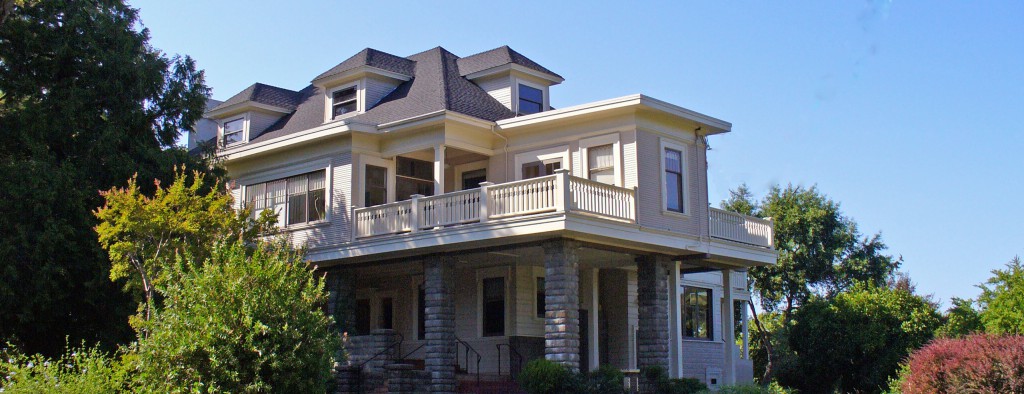
Robson-Harrington House, 2006
The dignified and imposing wood-frame mansion at 237 Crescent Road is the Robson-Harrington House. It is a San Anselmo landmark and town park.
The house, completed in 1906, was built by Edwin Kleber Wood on 2.68 acres that were deeded to him in March 1905 by San Anselmo real estate developers, Frederick Croker and George A. Raymond. Wood, the only son of farmers Cheney and Laura Brown Wood, was born in Wyoming County in western New York on February 17, 1840. He was educated in a local school and later attended nearby Pike Seminary.
In 1861, following Lincoln’s first call for 75,000 Union soldiers, Edwin K. Wood enlisted as a private in Company K, 17th New York State Infantry Regiment. The regiment was involved in some of the bloodiest Civil War battles, fighting with heavy losses at the second battle of Bull Run, Antietam and the Battle of Fredericksburg and Chancellorsville. Edwin was wounded at Hanover Court House and was discharged as a corporal after serving the regiment’s two-year term.
Edwin returned home and taught school for a short time. Growing restless and looking for opportunities in the west, he left home to engage in sheep raising in Iowa. On the train west, he met a timber broker who persuaded him to explore opportunities in the timber country of Stanton, Montcalm County, Michigan. Stanton was to Edwin’s liking and he remained there teaching in the local school.
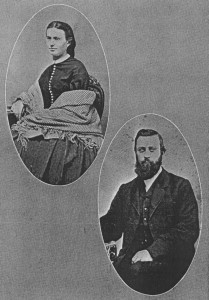
Marian Thayer & Edwin Wood shortly before their marriage in 1867.
In the latter part of 1866 he returned home and married Marian Susan Thayer in January 1867. Marian was born in 1844 in Wyoming County and attended Gainesville Female Seminary. Edwin and Marian left shortly after the wedding for Stanton.
Wood Builds a Lumber Company
During his first years in Michigan, Edwin took out contracts to supply logs for a mill and to build a road north from Stanton. Later, he established a general merchandise store to supply items needed in the lumbering community.
In 1874, Marian’s brother, Clarence A. Thayer, joined Edwin to help out in the store. This was the beginning of a partnership which would last until Edwin’s death in 1917. They purchased a mill in 1875, and expanded their lumber business over the years, becoming one of the largest lumber producers in Michigan.
His successful business demonstrated to Edwin that great opportunities could be found on the Pacific Coast. He made several trips to the coast and invested heavily in fir timber in Washington.
In 1885, Edwin K. Wood was elected as Representative to the Michigan State Legislature. About the same time, Wood sent employee, Spencer E. Slade, to Washington and then on to San Francisco. Slade established S. E. Slade & Company, the first office of what was to become the E.K. Wood Lumber Company. In 1888, partner Clarence Thayer moved to San Francisco and opened a wholesale lumberyard at the foot of Spear Street.
Business and Family Move West
In 1891, Edwin and Marian moved to Oakland. The E.K. Wood Lumber Company was incorporated in California in 1895, with Edwin serving as president until his death. The company prospered with large holdings in Washington and Oregon, docks in Oakland and San Pedro, a fleet of vessels plying its trade up and down the coast, and local yards and mills in Los Angeles, Oakland, San Rafael, San Anselmo, Fresno, San Francisco, and Bellingham, Washington.
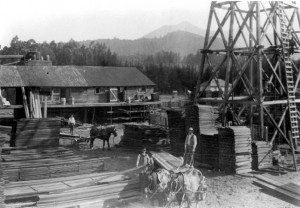
E.K. Wood Lumber & Mill Co., San Anselmo,, 1907
The San Anselmo yard, located on San Anselmo Avenue between Belle and Mariposa Avenues and extending to Richmond Road, was one of the largest in Marin. When it opened in 1905, thirty men were employed and six teams of horses hauled lumber, cement, and pipe from the freight yard at the Hub to the mill. A railroad spur later ran directly into the yard.
The Woods had two sons, Frederick John and Walter Thayer. A daughter died in infancy, and they also had an adopted daughter, Amy Houser. Frederick and Walter both were involved with their father’s company, with Frederick managing the Bellingham office, and Walter working in San Francisco.
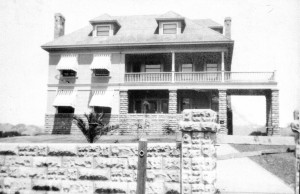
Original house shortly after completion, 1906
The family resided in Oakland, San Francisco and San Rafael prior to the move to San Anselmo. The two-story wood frame San Anselmo home was set on the slope of a hill with views of Mt. Tamalpais and Bald Hill in one direction and of Red Hill in the other. The original house, pictured here, is distinguished by its large size and straightforward design. The rusticated stone base and columns, the “belt” defining the border between the two floors, the hip roof and dormers on multiple sides, and the balustraded second floor porch extending out over the porte cochere provide interesting architectural details. Interior details, moldings, inlaid floors, rich wood paneling of curly redwood, oak, walnut, and birdseye maple, befit an owner prominent in the lumber industry. Originally, there was a large two-story carriage house to the right of the house.
The Woods took great interest in San Anselmo in its early years. They were regular attendees at First Presbyterian Church and were major contributors to the lot and building fund for the church manse at 201 Ross Avenue. They also contributed to local charities, including the Presbyterian Orphanage, and to San Francisco Theological Seminary. Though prominent citizens, the Woods lived a comparatively quiet life. Marian was remembered as being simple and domestic in her tastes and Edwin for his gentleness, fairness, and generosity.
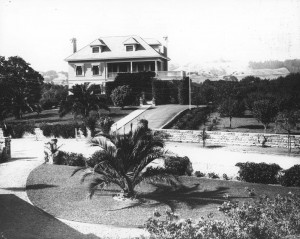
The house and garden, 1917
Marian and Edwin celebrated their golden wedding anniversary just six months before Edwin’s death on July 30, 1917 at age 77. His estate was valued at $2,000,000 and the inheritance tax on the estate was the largest that had ever been paid in Marin County.
Marian lived with her son Fred in Bellingham for a time and then returned to her San Anselmo home where she was residing with two housekeepers at the time of the 1920 census. A year later, in failing health, she moved to Oakland and died there February 4, 1922.
One of the E. K. Wood Lumber Company’s schooners has outlived the company’s and her namesake’s fame. The C. A. Thayer, named for partner and brother-in-law Clarence A. Thayer, is located at the San Francisco Maritime National Historic Park in San Francisco.
The Robson Years
In April 1923, the Wood heirs, Frederick and Walter Wood, sold the Crescent Road estate to Kernan and Geraldine Robson for $18,500.
Kernan Robson was born September 22, 1872 in Logan County Ohio, the second of three sons of Albert L. Robson and Frances Harrington. He was raised on the Robson’s farm in a clapboard-covered log cabin and educated in a one-room schoolhouse. By the time Kernan was 18 years old, his father was totally blind. As Albert Robson’s sight began to fail and he could no longer work the fields, he had his sons stretch wire and rope between the house and outbuildings so that he could feel his way to care for the farm animals. The sons did the fieldwork, clearing, plowing and harvesting. Fannie, always in knee-high cowhide boots, tended the house, garden, milk house and smokehouse, cared for her elderly mother-in-law, and raised her three sons, instilling in them strong work habits. She was known in her community for her charity and kindness.
It is this strength, work ethic, and true pioneer spirit that Kernan Robson was to later honor in designating that his bequest to San Anselmo be called Robson-Harrington Park. He always closed his office on the anniversary of his mother’s death, May 1st, in devoted memory to her.
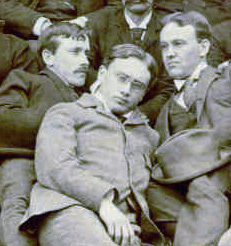
Kernan Robson, center, 1895
Kernan left the farm and received degrees from Ohio Wesleyan University and Ohio Northern University, where he was remembered by the University’s president as one of the hardest working students ever enrolled. He attended Harvard Divinity School for one year, and then traveled and studied at Oxford and in Germany. He became fluent in seven languages along the way. At his death, he left behind an unfinished thesis on Scottish essayist and historian Thomas Carlyle.
From 1895 to 1897, Kernan was Professor of English Language and Literature at the University of South Dakota. He left South Dakota for San Francisco and found employment as a newspaper reporter, then as a teacher at San Francisco’s Polytechnic and Lowell High Schools. He soon began to speculate in real estate. The earthquake and fire of 1906 provided great opportunities and, by 1910, Kernan had formed a San Francisco real estate partnership with Herman H. Sattler known as Robson & Sattler.
In 1908, Kernan married Geraldine Clark Baggs, the only child of Montgomery Baggs and Hattie Electa Clark, who both descended from pioneer California families. Geraldine was born in Stockton in1882, and moved with her parents to San Francisco and then to San Rafael. Montgomery Baggs was a marine and fire insurance broker in San Francisco. Geraldine’s maternal grandfather, Asa Clark, was a well-known physician in Stockton who for many years was the superintendent of the Stockton State Mental Asylum before opening his own hospital. In a 1984 interview, the Robson’s longtime housekeeper, Mae Orlandi, stated that Kernan had no money of his own, that it came through the marriage to Geraldine. Kernan and Geraldine made their home in Berkeley before purchasing the San Anselmo property.
The business partnership with Herman Sattler ended around 1920 when Kernan’s brother, McGary, joined him in the business. The Robson & Robson firm was prosperous with offices in the DeYoung Building at 690 Market Street.
The Robsons were a quiet couple without any children who became avid gardeners. They planted extensive orchards and a vineyard. They also added all the curving brick walls which surround the estate, using bricks salvaged from old houses acquired in the course of Mr. Robson’s business. Stonemasons adorned the grounds with archways, fountains, and walls imbedded with a treasure trove of architectural terracotta pieces manufactured by Gladding McBean & Co. of Lincoln, California. At one time, the Robsons had four fulltime gardeners on their staff along with a contingent of household help.
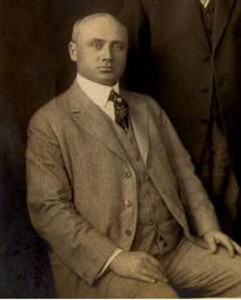
Kernan Robson, c. 1930
The Robsons expanded the original house. They expanded the dining room, added a terrace room, and enclosed the second floor porch adding a sunroom, sleeping porch, study, and outside shower.
As a young woman, Geraldine became interested in the art and history of Asia and started collecting Japanese netsukes (small sculptural objects, or toggles, usually worn to suspend objects hung from the sash of a kimono). Her approach was scholarly; she researched the story of each and recorded them in large ledger books. Her collection of 569 netsukes was willed to the University of California, where today they are housed at the Phoebe A. Hearst Museum of Anthropology.
Kernan was remembered by his grandnephew, William Lee Robson, as a caring person who shared his wide knowledge and material wealth with those less fortunate. Kernan Robson died on January 13, 1956 at the age of 83. His estate was valued at approximately $5 million. Under the terms of his will, Geraldine was provided for until her death, and bequests were made to employees, nieces and nephews and others. Professorial chairs in political science and government were endowed at Ohio Northern University, Ohio Wesleyan University, and the University of California, Berkeley.
The Robson’s Bequest to San Anselmo
The house and property at 237 Crescent were bequeathed to San Francisco Theological Seminary for educational, health or religious purposes or to the City of San Anselmo for use as a public park or playground, if the Seminary declined the bequest. This bequest was to become effective 20 years after Kernan’s death or upon Geraldine’s death. Geraldine continued to live in the house with housekeeper Mae Orlandi until her death on February 15, 1967.
The Seminary declined to accept the property, and it was offered to San Anselmo. In May 1968, San Anselmo formally accepted the property, agreeing that it be used as a park or playground for children, that it never be sold in whole or in part, or subdivided, or used for private or commercial purposes, and that it would be named Robson-Harrington Park as a tribute to the memory of Kernan Robson’s father and mother. Under the terms of the Robson’s will, Mae Orlandi continued to live in the house with a small stipend until her death in 1990.
On Sunday September 15, 1968, the estate was opened to the public for the first time, with a welcoming address by the mayor and guided tours of the house. San Anselmo was delighted with its new “relic.”
Budgetary Quicksand
For sixty years the estate had been maintained by two extremely wealthy families. Now the task fell to the Town of San Anselmo.
Immediately, the use of the park was debated by Council and the Parks and Recreation Commission. Should dances or the serving of alcohol be permitted? Should tennis courts and a tiny-tots playground be constructed? A town administrator voiced concern that the property could become “budgetary quicksand.”
Contributions were solicited for furnishings (folding chairs and table), a fundraising dinner dance was held, and the Robson Harrington Park Association was formed to raise money and stimulate community interest in the new park. After Kernan Robson’s death, only the front grounds had been maintained and now city workers cut back the overgrown gardens, revealing forgotten paths. The house and grounds were opened to the community in 1969 and became a key part of the town’s recreation program.
In 1972, Council approved the use of funds to improve the carriage house by rewiring, re-plumbing and repainting, but on the night of January 5, 1974 the carriage house was destroyed by fire. It had housed the Tiny Tots and Youth Center programs as well as other groups.
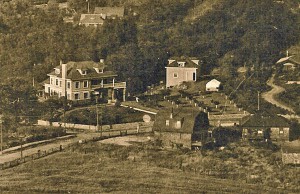
The house with carriage house to the right, c. 1911
With the passage of Proposition 13 in June 1978 and the reduction of property tax revenue, Town was forced to close the house and eliminate funds for repair and maintenance. The house had fallen into disrepair through neglect. The Ross Valley Ecumenical Housing Association came forward with a proposal to use the house for senior housing. Debate ensued.
A group of civic-minded residents formed a new Robson-Harrington House Association which successfully negotiated to lease the property for $1 per year. In exchange, the Association agreed to restore, manage and maintain the house as a civic, educational, recreational, and cultural center.
The Association used volunteer labor and donated materials to preserve the house. It made the house structurally sound and safe but lacked funds to refurbish the interior. Through a stroke of good fortune, the house was chosen to be used by the Marin Volunteer Bureau Designers Showcase in 1979 and the interior was restored to its former elegance.
For 25 years the Association was solely responsible for the house and its maintenance needs. The Association secured tenants for the 2nd floor and a caretaker, managed weekend rentals, set fees, collected revenue and reinvested proceeds into the house. The Recreation Department paid the Association for the use of the house on weekdays. The Parks Department was responsible for the routine maintenance of the grounds and park.
In 2005, the Robson-Harrington House Association was unable to find new board members willing to take on the considerable responsibilities. So, after having devoted itself to the property for those many years, this civic organization disbanded and management of the house reverted back to the town, along with some accumulated rentals. The Parks and Recreation Department now handles house and picnic area rentals.
A popular part of the park is the Community Garden, which includes about thirty individual fenced plots. Organic gardening practices are used exclusively.
Robson-Harrington Park is a unique civic treasure. Let’s hope that budgetary quicksand can be avoided and the Town of San Anselmo continues to maintain this unique estate for future generations to enjoy.
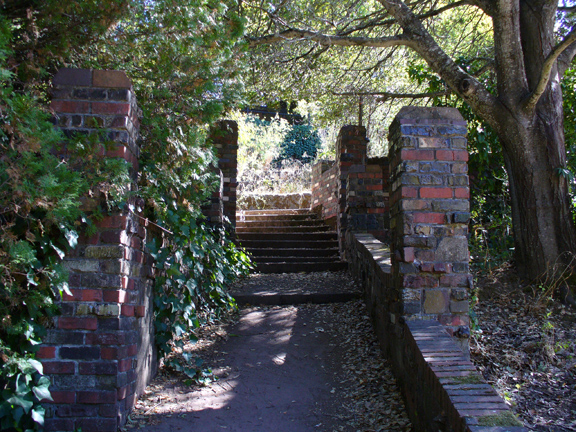
Garden Walkway, 2006

